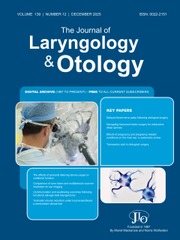No CrossRef data available.
Article contents
Inferior turbinate hypertrophy predicts adenoid hypertrophy in children with obstructive sleep disorders
Published online by Cambridge University Press: 30 July 2025
Abstract
Adenoid hypertrophy contributes to nasal obstruction and obstructive sleep disorders in children, but can be difficult to assess. This study examines whether inferior turbinate hypertrophy can predict adenoid hypertrophy severity in children with obstructive sleep disorders.
This retrospective cohort study included children (0–18 years) with a diagnosis of obstructive sleep-disordered breathing or obstructive sleep apnoea who underwent drug-induced sleep endoscopy. Analyses explored demographic, clinical and endoscopic associations with adenoid hypertrophy.
A total of 269 children were included. Separate univariate analyses showed that older age and greater inferior turbinate hypertrophy predicted greater adenoid hypertrophy (p < 0.05). However, in multivariate ordered logistic regression, only inferior turbinate hypertrophy remained significant (p < 0.01), while age did not (p = 0.11).
These findings suggest inferior turbinate hypertrophy may serve as a proxy for adenoid hypertrophy, aiding clinicians in assessment and guiding further evaluation or intervention.
Information
- Type
- Short Communications
- Information
- Copyright
- © The Author(s), 2025. Published by Cambridge University Press on behalf of J.L.O. (1984) LIMITED.
Footnotes
Hussein Jaffal takes responsibility for the integrity of the content of the paper

